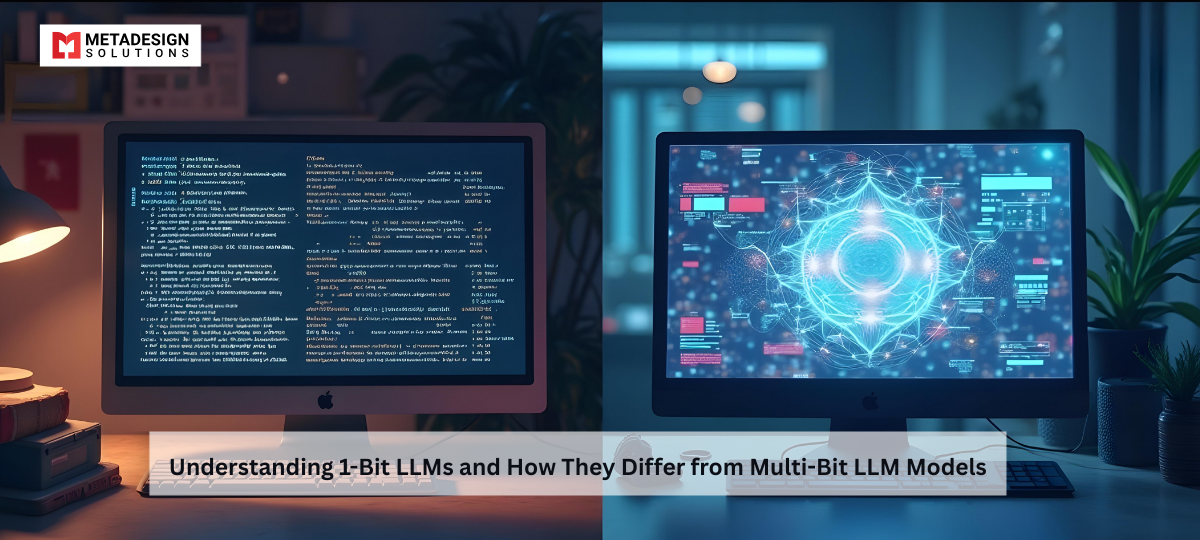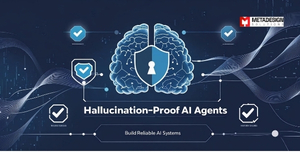Introduction to 1-Bit LLMs
What are 1-Bit LLMs?
Large Language Models (LLMs) are at the forefront of artificial intelligence, enabling applications ranging from natural language understanding to sophisticated generative tasks. A 1-bit LLM is a specialized type of LLM that leverages extreme quantization to represent its parameters (weights and activations) using just a single bit per value. This approach significantly reduces the memory footprint and computational requirements of the model. Leveraging LLM development services, these 1-bit models are designed to make AI more accessible for resource-constrained environments, such as edge devices and mobile platforms. Unlike traditional models that use multi-bit precision (e.g., 32-bit floating-point numbers), 1-bit LLMs offer innovative solutions for deploying AI in scenarios where resources are limited.
The primary goal of 1-bit LLMs is to optimize efficiency while maintaining an acceptable level of accuracy. By encoding model parameters in binary form, these models achieve significant compression and reduced computational complexity, making them ideal for scenarios where hardware resources are limited. Additionally, the reduced size of 1-bit LLMs simplifies the deployment process, allowing models to be incorporated into devices with limited processing power or storage capacity. This makes them especially valuable in areas like real-time applications, embedded systems, and mobile AI solutions.
By focusing on streamlined performance, 1-bit LLMs address a critical challenge in the AI domain: making cutting-edge technology accessible and practical for a wide array of applications. While they may not replace traditional multi-bit models in high-precision tasks, their potential to drive innovation in constrained environments ensures their growing relevance in the AI landscape.
The Concept of Quantization in Machine Learning
Quantization is a technique used in machine learning development services to reduce the precision of numerical representations, such as weights and activations, in neural networks. The standard practice involves converting 32-bit or 16-bit floating-point numbers into lower-precision formats like 8-bit integers or even binary (1-bit) values.
Key Benefits of Quantization:
- Memory Efficiency: Lower-precision representations significantly reduce the memory required to store model parameters.
- Speed Enhancements: Reduced precision accelerates computations, particularly on hardware optimized for low-precision arithmetic.
- Energy Savings: Quantization reduces the energy consumed during model inference, making it suitable for battery-powered devices.
However, quantization introduces a trade-off: lower precision often leads to a slight degradation in model accuracy. Advanced techniques like quantization-aware training and post-training quantization are used to mitigate this impact, ensuring that models retain their performance while benefiting from the efficiencies of quantization.
Understanding Multi-Bit LLMs
Overview of Multi-Bit Representation
Traditional LLMs use multi-bit representations, typically 16-bit or 32-bit floating-point numbers, to encode their weights and activations. This high precision allows these models to learn and represent complex patterns in data with minimal loss of information. Multi-bit LLMs are the standard choice for tasks requiring high accuracy, such as natural language processing, computer vision, and scientific simulations.
Multi-bit representation ensures:
Rich Representational Power: Models can capture subtle nuances in data.
Stability in Training: High precision reduces numerical errors during backpropagation and gradient updates.
Versatility Across Applications: Multi-bit LLMs are well-suited for a wide range of tasks without requiring extensive optimization.
Advantages and Limitations of Multi-Bit Models
Advantages:
- High Accuracy: Multi-bit models can learn and generalize better, especially for complex datasets.
- Ease of Training: The high precision minimizes issues like vanishing or exploding gradients.
- Compatibility: Most existing frameworks and hardware are optimized for multi-bit models.
Limitations:
- High Resource Demand: Multi-bit models require substantial memory and computational power.
- Energy Consumption: Running inference on multi-bit models can be energy-intensive, limiting their use on edge devices.
- Scalability Challenges: Deploying multi-bit models in large-scale, real-time applications can be prohibitively expensive.
How 1-Bit LLMs Work
Binary Representation of Weights and Activations
In 1-bit LLMs, the weights and activations are represented as binary values—either 0 or 1. This binary encoding drastically reduces the memory required to store these parameters. For example, a model with 1 billion parameters would require only 125 MB of storage in a 1-bit format, compared to 4 GB for a 32-bit model.
Binary representation relies on the following principles:
- Thresholding: Continuous values are mapped to binary states based on a threshold. For instance, values above a certain cutoff are set to 1, while others are set to 0.
- Sign Encoding: Instead of absolute values, the binary format can represent the sign (positive or negative) of a parameter to encode directional information.
While this reduces precision, the overall structure of the data is retained, enabling the model to perform its tasks with minimal loss in accuracy.
Training Techniques for 1-Bit Models
Training 1-bit LLMs poses unique challenges due to the limited precision of binary representation. Specialized techniques are employed to achieve acceptable performance:
- Quantization-Aware Training (QAT):
- The model is trained with quantization effects simulated during the forward and backward passes. This ensures that the binary representation does not significantly impact the model’s ability to learn.
- Gradient Clipping:
- Gradients are clipped to prevent instability during training, which is common when using low-precision representations.
- Error Compensation:
- Techniques like stochastic rounding are used to minimize the cumulative error introduced by quantization.
- Distillation:
- A high-precision model (teacher) guides the training of the 1-bit model (student) to enhance its learning efficiency and accuracy.
By employing these methods, 1-bit LLMs can be effectively trained to deliver efficient and accurate performance, making them a promising alternative in resource-limited settings.
Comparison: 1-Bit vs. Multi-Bit LLMs
Performance Trade-Offs
The primary trade-off between 1-bit and multi-bit LLMs lies in their balance of efficiency and accuracy. While 1-bit LLMs excel in reducing computational and memory demands, they may sacrifice some performance in complex tasks requiring high precision. Multi-bit LLMs, on the other hand, provide superior accuracy and flexibility but at the cost of higher resource consumption.
Memory and Computational Efficiency
1-bit LLMs offer unparalleled efficiency:
- Memory Usage: A 1-bit model requires a fraction of the memory needed by multi-bit models. For instance, a 32-bit model consumes 32 times more memory than its 1-bit counterpart.
- Computation Speed: Binary operations are significantly faster than floating-point calculations, enabling quicker inference times, especially on hardware optimized for low-precision arithmetic.
However, multi-bit models’ higher precision makes them better suited for tasks where memory and computation are less constrained.
Accuracy and Precision Differences
1-bit LLMs inherently lack the precision of multi-bit models, leading to:
- Reduced Accuracy: Particularly noticeable in tasks involving subtle patterns or complex relationships in data.
- Quantization Errors: The binary representation can introduce approximation errors, which must be mitigated through advanced training techniques.
Multi-bit models maintain superior accuracy but demand significantly more resources, making them impractical for certain applications.
Unlock the Potential of 1-Bit LLMs
Interested in deploying efficient AI models on edge devices? Schedule a consultation with MDS to explore 1-bit LLM solutions tailored to your needs.
Applications of 1-Bit LLMs
Use Cases in Resource-Constrained Environments
1-bit LLMs shine in environments where computational and memory resources are limited. Examples include:
- Edge Computing: Deploying AI models on IoT devices and smartphones to perform tasks like image recognition or natural language processing locally, without relying on cloud services.
- Battery-Powered Devices: Ensuring energy efficiency for prolonged operation, particularly in wearable tech and portable medical equipment, where conserving battery life is crucial.
- Real-Time Processing: Achieving low-latency inference in embedded systems, such as automotive safety systems, where immediate responses are essential.
Industries Benefiting from 1-Bit Models
- Healthcare: Enabling AI-powered diagnostics on portable devices, such as handheld ultrasound machines, that can operate in remote or resource-limited settings.
- Finance: Accelerating fraud detection in real-time by deploying models directly on transaction terminals, reducing latency associated with cloud communication.
- Retail: Enhancing customer experiences with on-device recommendation systems that personalize shopping suggestions without requiring constant internet connectivity.
- Autonomous Systems: Supporting navigation and decision-making in drones and robots operating in dynamic environments where computational resources are limited.
Challenges in 1-Bit LLM Development
Maintaining Model Accuracy
One of the most significant challenges in developing 1-bit LLMs is preserving accuracy. Quantization introduces noise and reduces the model’s ability to capture subtle patterns in data. Researchers must employ techniques like quantization-aware training and knowledge distillation to mitigate these effects, especially when building robust applications with frameworks like LangChain: Building Applications with Language Models, which require precise language understanding.
Handling Complex Tasks with Limited Precision
Tasks requiring intricate reasoning or fine-grained distinctions are particularly challenging for 1-bit LLMs. Developers must carefully design the model architecture and training process to balance efficiency with task complexity.
By addressing these challenges, 1-bit LLMs can become a viable solution for a broader range of applications, pushing the boundaries of what is achievable with quantized AI models.
Future of 1-Bit LLMs
Advances in Quantization Techniques
The future of 1-bit LLMs lies in ongoing advancements in quantization methods. Researchers are exploring:
- Adaptive Quantization: Dynamically adjusting quantization levels based on task requirements.
- Hybrid Precision Models: Combining 1-bit and multi-bit layers to optimize performance.
- Improved Training Algorithms: Developing novel techniques to reduce quantization errors and enhance training stability.
Integration with Hardware Accelerators
Hardware innovations are pivotal in unlocking the full potential of 1-bit LLMs. New developments include:
- Custom AI Chips: Processors specifically designed for binary computations.
- Energy-Efficient Architectures: Hardware optimized for low-power operations.
- FPGA and ASIC Designs: Tailored solutions for deploying 1-bit models in real-time systems.
When to Choose 1-Bit LLMs Over Multi-Bit Models
Scenarios Favoring 1-Bit Models
1-bit LLMs are ideal for:
- Edge Devices: Environments with stringent memory and energy constraints.
- Cost-Sensitive Deployments: Applications requiring affordable scalability.
- Latency-Critical Tasks: Use cases demanding real-time responses, such as voice assistants and IoT devices.
Trade-Offs to Consider
While 1-bit models offer efficiency, they are less suitable for:
- High-Precision Tasks: Complex applications like scientific computing or fine-grained NLP tasks.
- Dynamic Workloads: Scenarios requiring frequent model updates or retraining.
Learning Resources and Tools
Frameworks and Libraries for 1-Bit LLMs
Developers can leverage various tools to experiment with 1-bit models, including:
- PyTorch: Supports quantization-aware training with extensions for binary models.
- TensorFlow Lite: Offers capabilities for running quantized models on edge devices, supporting binary and low-precision inference.
- ONNX Runtime: Enables efficient deployment of quantized models across platforms with support for custom kernels.
- Brevis: A specialized framework designed for training and deploying extreme quantized models, including 1-bit LLMs.
Research Papers and Studies on Quantized Models
- “Quantization-Aware Training for Transformers”: Explores techniques to preserve accuracy in highly quantized transformer architectures.
- “Binary Neural Networks: A Review”: A comprehensive analysis of the evolution and challenges in binary neural networks.
- “Efficient NLP with Quantized Transformers”: Discusses the trade-offs and benefits of applying quantization to large-scale language models.
These resources provide a solid foundation for understanding the principles, advancements, and practical applications of 1-bit LLMs.
Conclusion
Key Takeaways on 1-Bit LLMs
- Efficiency First: 1-bit LLMs prioritize memory efficiency and computational speed, making them ideal for resource-constrained environments.
- Applications Abound: Their utility spans industries from healthcare to IoT, proving their versatility in real-world scenarios.
- Trade-Offs: While they excel in efficiency, maintaining accuracy and handling complex tasks remain ongoing challenges.
Future Outlook on Quantized LLMs in AI Development
The future of 1-bit LLMs is promising, driven by innovations in quantization techniques and hardware accelerators. As AI continues to push boundaries, 1-bit models are poised to play a critical role in democratizing access to advanced AI capabilities, especially for edge and mobile applications. Their evolution will likely pave the way for even more extreme quantization methods, enabling AI to reach new levels of efficiency without compromising on performance.
By embracing AI development services, developers can unlock the potential of 1-bit LLMs in scenarios previously deemed impractical. These services empower businesses to implement cutting-edge solutions, driving innovation and impact across the globe. As the field evolves, AI development services will be instrumental in making advanced LLM technologies accessible and efficient for diverse applications.
Related Keyphrase:
#LLM #LargeLanguageModels #1BitLLM #MultiBitLLM #AI #MachineLearning #DeepLearning #AIOptimization #AIModels #EfficientAI #AIEngineering #ModelCompression #AIInsights #AIResearch #TransformerModels #AIApplications #GenerativeAI #NLP #AIInnovation #TechExplained #AIFuture #AITrends #AIRevolution #AIConcepts



